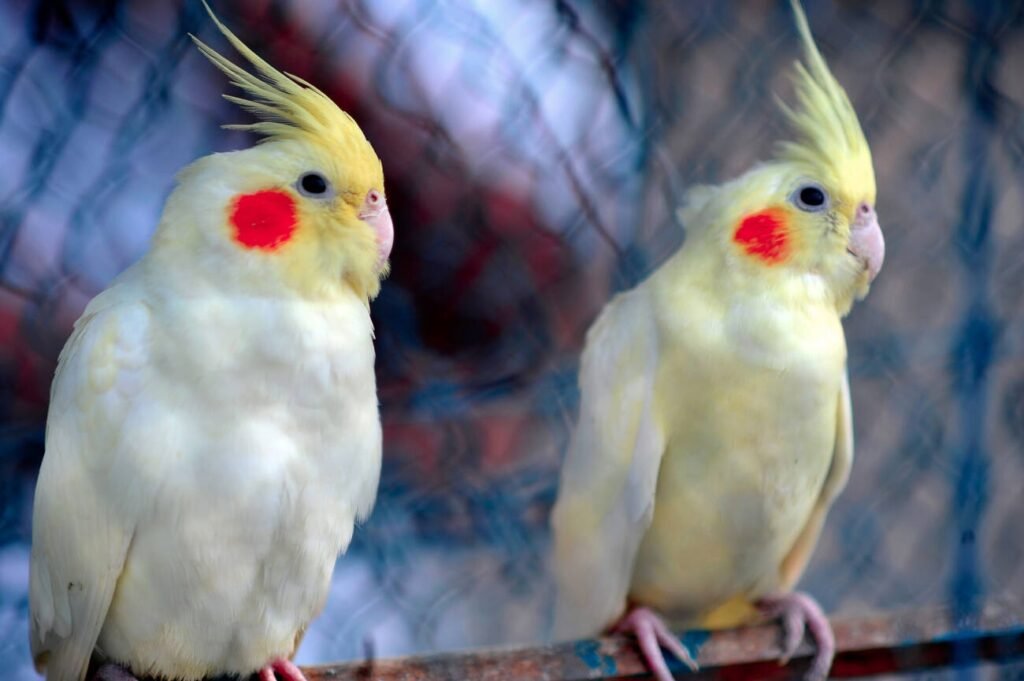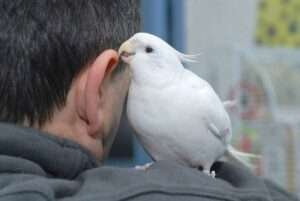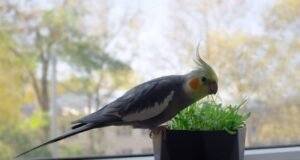Understanding Male and Female Cockatiel Behaviors

Cockatiels are cherished for their lively personalities, intelligence, and beautiful plumage. If you’re a bird lover or breeder, like myself, you’ve likely noticed that male and female cockatiels display distinct behaviors and physical traits. With over a decade of experience and more than 50 cockatiels in my collection, I’ve observed these subtle and sometimes not-so-subtle differences.
In this extensive guide, we’ll explore the unique nesting and brooding behaviors of cockatiels, delve into their distinctive physical characteristics—like body plumage and tail markings—and learn how to properly care for and interact with these beautiful creatures.
Understanding Male and Female Cockatiel Behaviors
Cockatiels are social, intelligent birds, but their behavior can vary depending on their gender, hormonal state, and environment. Understanding these gender-specific behaviors can help you provide a better environment for your cockatiels and foster a closer bond with them.
Here, we’ll explore some of the key behaviors exhibited by male and female cockatiels, focusing on:
- Nesting and brooding behaviors in females
- Territoriality and vocalization differences between genders
- Physical characteristics, including body plumage and tail markings
This guide will provide you with actionable tips on how to care for both male and female cockatiels, including during their nesting and breeding phases.
Nesting Behaviors in Female Cockatiels
Nesting behavior is one of the most distinguishing traits of female cockatiels, particularly during the breeding season. Hormonal changes prompt females to engage in nesting activities as they prepare to lay eggs.
Key Nesting Behaviors
Shredding Paper and Materials: One of the first signs of nesting behavior is the female cockatiel’s instinct to gather nesting materials. This behavior is natural as females work to create a cozy nest for their future offspring. It’s common for females to shred paper, cardboard, or other cage materials, which they will then use to build their nest.
Tip: To help fulfill this nesting instinct, provide safe, untreated materials like paper, straw, or coconut fibers for them to shred and use in their nest.
Rearranging Cage Accessories: Female cockatiels will often rearrange their cage environment to find or create a secluded area for nesting. You might see them moving toys or cage accessories to carve out a hidden corner that feels safe and private.
Increased Time Near Nesting Areas: As the nesting season progresses, females tend to spend more time around potential nesting areas. They may become protective of these spots, especially as they prepare to lay eggs.
Aggression Toward Perceived Threats: Once a nest has been established, female cockatiels become protective. They may display aggression toward other birds or humans who come too close to their nest. This territorial behavior is driven by their instinct to protect their future offspring.
How to Support Female Cockatiels During Nesting
To help your female cockatiel during this time:
Provide Nesting Materials: Make sure your bird has access to safe and comfortable nesting materials. Avoid artificial or chemically treated items, as they could be harmful.
Create a Calm Environment: Minimize stress by maintaining a quiet space for your cockatiel. Loud noises or too much foot traffic near their cage can lead to anxiety and disrupt nesting behaviors.
By recognizing these nesting behaviors, you’ll be better equipped to provide a supportive environment for your female cockatiel during the breeding season.
Brooding Behaviors in Female Cockatiels
After the eggs are laid, female cockatiels enter the brooding stage. During this period, the female will spend most of her time incubating the eggs, ensuring that they develop properly and hatch successfully.
What is Brooding?
Brooding is the process by which female cockatiels incubate their eggs, utilizing their body heat to maintain the right temperature for embryonic development. This is a delicate time, as the female cockatiel’s priority becomes protecting and nurturing her eggs.
Key Brooding Behaviors
Sitting on the Eggs for Extended Periods: Once the eggs are laid, the female will spend long periods sitting on the nest to keep the eggs warm. It’s crucial for the eggs to remain at a constant temperature, so brooding females are highly dedicated during this time.
Heightened Alertness: Female cockatiels exhibit an increased sense of awareness and protectiveness during brooding. Any perceived threat to their eggs, whether another bird or a human hand, will be met with defensive behavior.
Physiological Changes: The body of a brooding female undergoes various hormonal and metabolic changes to support the demands of incubation. You may notice changes in appetite or behavior as her energy is redirected towards supporting the embryos.
The Brooding Period
The brooding stage typically lasts for 18 to 21 days, depending on the species and environmental conditions. During this time, it’s important to provide a stress-free, quiet environment to ensure the eggs hatch successfully.
Supporting Your Female Cockatiel During Brooding
Minimize Disturbances: Make sure your bird has a calm, quiet space to brood. Too much noise or handling can cause unnecessary stress, which may negatively affect the incubation process.
Monitor Health: Keep an eye on your brooding female to ensure she remains in good health. Monitor her food and water intake, and provide a balanced diet to support her increased nutritional needs during this time.
Male and Female Cockatiel Vocalizations
One of the most noticeable differences between male and female cockatiels is in their vocalizations. Male cockatiels tend to be more vocal, while females are often quieter, though this can vary by individual.
Vocalization in Male Cockatiels
Chirping, Whistling, and Mimicry: Male cockatiels are known for their ability to whistle, mimic sounds, and perform more complex vocalizations. Males often use these vocal displays to attract females, particularly during the breeding season.
Calling for Attention: Male cockatiels are social and will often call out for attention. Whether it’s mimicking sounds they hear around the house or interacting with their human caregivers, male cockatiels are vocal companions.
Female Vocalization
- Quieter and Subtler: Female cockatiels are generally quieter than males. While they still chirp and communicate with their human companions, their vocalizations tend to be less frequent and less complex. Some females, however, can be just as talkative as males, depending on their individual personality.
Body Plumage: Physical Differences Between Males and Females
The differences between male and female cockatiels aren’t just behavioral—there are also clear distinctions in their physical appearance, especially when it comes to their plumage.
Male Cockatiel Plumage
Brighter Colors: Male cockatiels typically have brighter and more vibrant plumage than females. Their feathers often display bold colors like bright yellow, white, and orange, especially on their face and crest.
Distinct Color Patterns: Male cockatiels are known for their striking color patterns, which are more pronounced compared to females. These patterns are particularly noticeable on their wings, back, and face.
Female Cockatiel Plumage
- Softer, Subdued Colors: Female cockatiels tend to have softer and more muted colors. Their feathers are often more uniform, with less contrast between their body feathers and facial markings. In many cases, females have a more subdued version of the male’s coloring, though some mutations can blur these differences.
Tail Markings: An Easy Way to Identify Gender
Tail markings provide another reliable way to distinguish between male and female cockatiels, especially in certain mutations like the common grey cockatiel.
Male Tail Markings
- Bold Yellow or White Barring: Males often display bright yellow or white barring on the underside of their tail feathers. This distinctive pattern is easy to spot and serves as a reliable indicator of gender in many cases.
Female Tail Markings
- Subdued or Uniform Tail Coloration: Female cockatiels typically have less pronounced tail markings. Their tail feathers tend to be more uniform in color, with minimal barring or patterning compared to males. In some cases, the markings may be faint, but they’re generally less vibrant than those found in males.
Understanding Cockatiel Body Language
Beyond vocalizations and plumage, cockatiels communicate through expressive body language. Both male and female cockatiels use their bodies to convey a wide range of emotions and intentions, from excitement to fear.
Common Body Language Signs
Head Bobbing: Often a sign of excitement or curiosity. Male cockatiels, in particular, will bob their heads while performing a “dance” to attract a mate.
Crest Raising: The crest feathers on a cockatiel’s head are a key indicator of mood. A raised crest generally means the bird is excited or alert, while a flattened crest suggests fear or aggression.
Wing Stretching and Tail Fanning: Cockatiels will stretch their wings and fan out their tail feathers as part of their grooming routine, but they may also do this when they feel threatened or want to appear larger.
How to Bond with Your Cockatiel
Building a strong bond with your cockatiel—whether male or female—takes time, patience, and understanding. By paying attention to their individual personalities and respecting their needs, you can create a positive relationship with your feathered friend.
Spend Quality Time with Your Cockatiel
Cockatiels are highly social birds that thrive on interaction, both with their human caregivers and other birds. To strengthen your bond:
Talk to Them Regularly: Cockatiels enjoy the sound of their caregiver’s voice. Spend time each day talking to your bird in a calm, soothing tone to help them feel safe and comfortable in your presence.
Hand Training and Handling: Teaching your cockatiel to perch on your finger is a great way to build trust. Start slowly by offering your hand near their cage, letting them come to you at their own pace. Over time, you can encourage them to step up onto your hand by offering treats and gentle encouragement.
Offer Physical Affection: Many cockatiels enjoy gentle scratches on the head or neck. Approach them slowly and carefully to see if they are receptive to being petted. Always respect their boundaries and stop if they show signs of discomfort or agitation, such as crest flattening or hissing.
Playtime and Exploration: Cockatiels love to explore their surroundings and play with toys. Offer a variety of safe, bird-friendly toys like ropes, swings, and puzzle toys to keep your cockatiel mentally stimulated. Regular out-of-cage time allows your cockatiel to stretch its wings and explore, fostering a sense of security and trust.
Use Positive Reinforcement
Positive reinforcement through treats, praise, and rewards can go a long way in building a healthy, trusting relationship with your cockatiel. When your bird exhibits desirable behavior, such as stepping onto your hand or responding to your voice, reward them with a small treat or verbal praise.
- Training Sessions: Short, consistent training sessions can help build a bond. Focus on simple commands like “step up” and reward your bird with treats for complying. Keep sessions short and fun to avoid overwhelming them.
Recognize and Respond to Their Needs
Understanding your cockatiel’s body language and behavior will help you create a nurturing environment. Watch for signs that your bird is content, stressed, or in need of attention:
Happy Cockatiel: A content cockatiel will often chirp softly, whistle, or make gentle, rhythmic sounds. They may also engage in grooming, fluffing their feathers, and preening.
Stressed Cockatiel: Signs of stress include loud, continuous squawking, feather plucking, or hiding in corners of the cage. If you notice these behaviors, assess the bird’s environment for potential stressors, such as too much noise or not enough interaction.
Male vs. Female Cockatiel Behavior: A Recap
To summarize the key differences between male and female cockatiels, here’s a quick recap of the primary distinctions:
Nesting Behavior: Female cockatiels exhibit nesting behaviors during the breeding season, shredding paper and preparing secluded areas for egg laying. Males, while not nesting, may still show interest in the breeding environment by vocalizing more to attract the female.
Brooding: Females take on the role of incubating eggs, whereas males may assist by guarding the nest or participating in feeding duties after the eggs hatch.
Vocalization: Males are generally more vocal than females, frequently whistling, chirping, and mimicking sounds. Females tend to be quieter but may still chirp and communicate in a softer tone.
Plumage: Male cockatiels typically have brighter, more defined colors, especially in their facial markings and tail feathers. Females display softer, more subdued coloration.
Tail Markings: Males often have bold yellow or white barring on their tail feathers, while females have more uniform or faint tail markings.
Cockatiel Health and Wellness
Maintaining your cockatiel’s health is essential for their happiness. Whether male or female, the following tips will help you provide the best care:
Diet and Nutrition
Cockatiels require a balanced diet to stay healthy and active. A good diet should consist of:
Pellets or Seeds: Pellets are a balanced option that provides the essential vitamins and minerals your bird needs. Seeds can be offered in moderation, but avoid a seed-only diet, as it lacks essential nutrients.
Fresh Fruits and Vegetables: Provide a variety of bird-safe fruits and vegetables, such as apples (no seeds), carrots, broccoli, and leafy greens. These offer additional vitamins and minerals to support overall health.
Fresh Water: Clean, fresh water should always be available. Consider using purified water, as I’ve found it important to ensure the best quality water for cockatiels, especially if your tap water is not optimal.
Hygiene and Grooming
Cockatiels are naturally clean birds that enjoy preening and grooming. To support their hygiene:
Regular Bathing: Offer your bird a shallow dish of water for bathing or use a spray bottle to mist their feathers. Bathing helps keep their feathers clean and reduces the risk of skin irritation.
Beak and Nail Maintenance: Cockatiels need to wear down their beaks and nails naturally by chewing on safe materials like cuttlebone or mineral blocks. If needed, you can have a professional trim their nails.
Exercise and Enrichment
Cockatiels are energetic and need regular exercise to stay healthy. To encourage activity:
Out-of-Cage Time: Allow your cockatiel to fly around in a safe, enclosed space. Flying is excellent for their cardiovascular health and overall well-being.
Interactive Toys: Provide a variety of toys, such as swings, ladders, and foraging toys, to keep your cockatiel mentally and physically stimulated. Rotate toys regularly to keep their interest.
Common Cockatiel Health Issues to Watch For
As with any pet, it’s important to be aware of common health issues that may affect cockatiels. Early detection is key to preventing serious illness.
Respiratory Issues: Cockatiels can develop respiratory problems, often signaled by sneezing, wheezing, or labored breathing. Dust, strong odors, or poor ventilation can contribute to these issues. Ensure your cockatiel’s environment is clean and well-ventilated.
Feather Plucking: Feather plucking can be a sign of stress, boredom, or an underlying health condition. If you notice your bird excessively plucking its feathers, consult an avian veterinarian to rule out health problems and consider enriching your cockatiel’s environment to reduce stress.
Egg Binding (in Females): Female cockatiels may occasionally experience egg binding, a condition where they are unable to pass an egg. This is a medical emergency that requires immediate veterinary attention. Symptoms include lethargy, straining, or a swollen abdomen.
Conclusion: Understanding and Caring for Your Cockatiel
In conclusion, both male and female cockatiels have unique traits that make them wonderful, interactive companions. From nesting and brooding behaviors in females to the vocal prowess of males, understanding these gender-specific behaviors is crucial for providing the best care possible.
By recognizing their needs, bonding through daily interaction, and supporting their health and well-being, you’ll create a nurturing environment where your cockatiel can thrive. Whether you’re enjoying the vibrant plumage of a male cockatiel or marveling at the nurturing instincts of a female, each aspect of their behavior contributes to a fascinating and fulfilling relationship with these wonderful birds.



